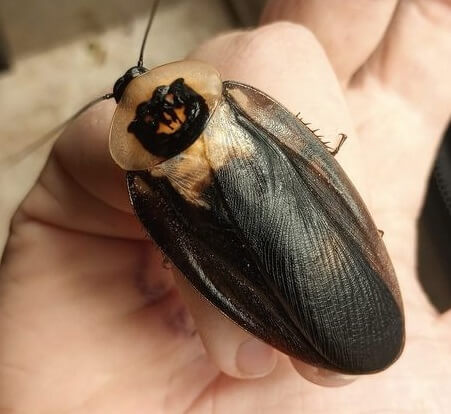Largest Cockroach Species

Have you ever wondered, “What’s the largest cockroach species in the world?” The thought might send shivers down the spine of many, but for entomology enthusiasts and those with a curious mind.
The answer is an intriguing journey into the world of these resilient insects. Let’s dive deep into this topic, and by the end, you might have a newfound appreciation for these oft-misunderstood creatures.
Largest Cockroach Species Table
This comparison table will provide you with all the necessary information at once.
| Species | Max Size | Key Features | Range |
|---|---|---|---|
| Megaloblatta Longipennis | 3.8 inches | Largest in length | Colombia, Ecuador, Peru |
| Giant Burrowing Cockroach | 3.1 inches | Heaviest cockroach | Queensland, Australia |
| Brazilian Cockroach | 3.9 inches | Largest cave cockroach | Brazil, Colombia, Central & North America |
| Megaloblatta Blaberoides | (Not specified by wingspan: 7.1 inches) | Largest wingspan | Guatemala, Panama |
| Madagascar Hissing Cockroach | 3 inches | Hissing ability | Madagascar |
| Death’s Head Cockroach | 2+ inches | Flight capability | West Indies, Mexico, Southern Florida |
| American Cockroach | 2.1 inches | Largest indoor cockroach | Global, prevalent in North America |
Megaloblatta Longipennis

Regarded as the undeniable monarch of the cockroach realm, the Megaloblatta longipennis is a marvel of the insect world. Stretching to an impressive maximum length of 3.8 inches, its vast wingspan measuring up to 9 inches often leaves enthusiasts in awe.
What’s equally fascinating is its geographical range. It primarily calls the Northwestern parts of South America home, with a particular affinity for regions in Colombia, Ecuador, and Peru.
Its appearance, a captivating dark brown hue complemented by subtle red undertones, adds to its mystique and sets it apart from many of its contemporaries.
Giant Burrowing Cockroach

Though the Megaloblatta Longipennis often garners attention for its length, the Giant Burrowing Cockroach, bearing the scientific name Macropanesthia rhinoceros, has carved its niche by being the heaviest of its kind.
This burrow-loving insect is native to the serene woodlands of Queensland, Australia. With a potential size of up to 3.1 inches, its weight isn’t its only standout feature.
The Giant Burrowing Cockroach has perfected the art of subterranean living, forging homes several feet beneath the earth. This tactic has allowed it to evade many above-ground threats and predators.
Brazilian Cockroach

The Brazilian cockroach, scientifically known as Blaberus giganteus, holds its ground with a remarkable size. Particularly impressive are the females, with some growing to a commanding 3.9 inches.
Their habitat choices reflect their preference for warmth and humidity. Thriving in the shadowy recesses of caves, they play a critical role in the ecosystem, consuming decaying vegetation and carrion, ensuring the natural decomposition cycle continues uninterrupted.
Megaloblatta Blaberoides

Central America boasts of its own giant in the form of the Megaloblatta blaberoides. While it might not claim the top spot in length, its wingspan is nothing short of spectacular, spanning a breathtaking 7.1 inches.
These wings are not just for show; they come alive during the nocturnal hours as the cockroach ventures out, painting an almost ethereal picture against the night sky.
Madagascar Hissing Cockroach

Madagascar’s rich biodiversity has yet another feather in its cap — the Madagascar Hissing Cockroach. Measuring around 3 inches, it might not be the largest, but it certainly is one of the most unique.
What distinguishes it is its signature hiss, a sound it produces by forcing air through the small openings in its abdomen. This sound serves as both a mating call and a deterrent for potential threats, showcasing the cockroach’s versatile communication skills.
Death’s Head Cockroach

With a name that sends chills down the spine, the Death’s Head Cockroach is every bit as intriguing as its title suggests. Growing to lengths exceeding 2 inches and gifted with the ability to fly considerable distances, this species has firmly staked its claim in the insect kingdom.
While its name might hint at something menacing, its habitat is relatively benign, favoring the warm subtropical climates stretching from Central America to the southern regions of Florida.
American Cockroach

The American Cockroach is the most universally recognized member of the cockroach family. Best known for its title as the largest cockroach species that prefers indoor habitats, it measures up to a significant 2.1 inches.
But size isn’t its only defining trait. The American Cockroach is a master adapter, showcasing a remarkable ability to adjust to varied environments and food sources, making it one of the most resilient species in the world.
Conclusion
In conclusion, while cockroaches might not be everyone’s favorite creatures, their diversity, adaptability, and sheer size in some species can’t help but evoke admiration. They have survived for millions of years, and understanding them is not just fascinating but essential as they play crucial roles in our ecosystems.

James E. Butkovich, Pest control maven with a knack for eco-friendly & Chemical solutions. Blogger with a mission to make homes pest-free, one post at a time.